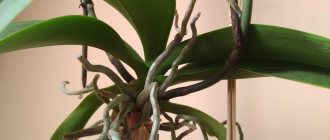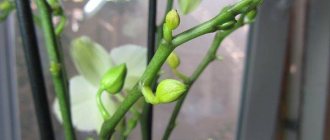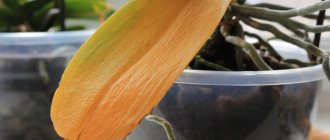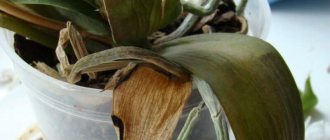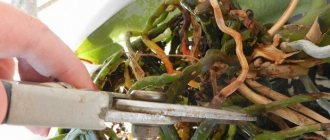Features of the root system
Orchid aerial roots are roots that grow outside of the potting medium. They can grow from stem nodes at the top of the stem or emerge from potting soil. Some orchids produce many aerial roots, while others have few or no roots.
Orchids are natural epiphytic plants. This means they grow on other plants rather than in soil. Roots are responsible for anchoring the plant in place of growth, as well as for absorbing necessary water and nutrients.
Aerial roots are not that rare. But if you are new to growing phalaenopsis orchids, this term may not be familiar to you. The appearance of roots above the surface of the pot does not mean that the orchid has become cramped in the pot and needs to be replanted - just air outlets have begun to grow in the plant.
Also find out what to do if the peduncle of an orchid has dried up.
Structure
The structure of phalaenopsis aerial roots is very different from the structure of ordinary roots of land plants. The spongy tissue velamen covers the inner filamentous part of the root with a thick layer of epidermal cells. Velamen helps orchids cling to tree branches, absorb water and nitrogen from the air , protects them from damage and retains moisture, thereby providing water to the entire plant and protecting it from drying out.
Aerial roots are natural to epiphytic species that grow on other plants in tropical forests. Unlike terrestrial orchids, which root in the ground, epiphytic species naturally grow above ground, using their roots to attach themselves to tree branches and reach brighter areas among the foliage.
Unlike other plants that attach themselves to trees, phalaenopsis orchids are not parasitic or invasive. Epiphytes, with a unique root system, use their roots to absorb nutrients, moisture and carbon dioxide to grow and survive directly from the air, without feeding on tree sap .
We recommend reading how to propagate an orchid from cuttings at home.
Appearance
Although aerial roots do not improve the aesthetic appearance of the flower, nothing needs to be done with them - this is the natural development of the plant. They are cylindrical or flat in shape and should be firm to the touch.
The aerial roots become bright green immediately after watering, which is a sign of healthy roots. As they dry, they first turn silver and then gray or whitish, which means that the orchid may need watering . Just soak the roots for 2 minutes or spray them with water and they will turn green again.
Choosing the right filler for planting
This is the real cause for concern. You need to act immediately before the plant is completely destroyed. To do this, the rosette of the plant along with the roots must be removed from the pot, the roots must be thoroughly washed, disinfected, blotted from excess moisture and carefully removed the rotten shoots of the roots. After all the procedures performed, the plant must be planted in a new transparent flower pot filled with fresh bark prepared for planting orchids.
Another common reason for the appearance of aerial roots is the wrong mixture for planting orchids. Phalaenopsis should be planted in specially prepared bark and moss; under no circumstances should an earthen substrate be used. Soil is a very dense substance for phalaenopsis roots, so they do not grow into the ground, but shoot up. Those who had experience of planting orchids in an earthen substrate could see from their own experience that the roots of the orchid rot in the ground.
Immediately after transplantation, phalaenopsis can be watered for some time only with purified water without adding fertilizers, so as not to burn the weakened roots with the mineral solution.
Orchid transplantation - where to put the roots?
One of the features of an orchid is its replanting. The process proceeds differently than in other plants. The first thing they think about when replanting an orchid is where to put the aerial roots? After a new pot has been selected, the mixture has been prepared, and the root system has been washed, a little substrate is added to the bottom of the container. Then the aerial roots are straightened from above as much as possible. The space between them and the walls is filled with soil mixture.
When replanting, doubts arise: is it necessary to bury the aerial roots of the orchid? You shouldn't do this. Over time they will find a suitable position.
Many people wonder whether it is necessary to cut off the aerial roots of an orchid. The reason is the somewhat unaesthetic appearance of the flower. But no matter how many aerial roots there are, they cannot be touched. In particular, it cannot be cut off, because through the roots the flower receives nutrients from the air.
In nature, a flower feels great with aerial roots. They help us survive and get food. In an apartment, the roots do not look so presentable. But this is already a unique feature of the orchid. If there are too many of them, you should transplant the plant into a larger pot.
Darkening of the roots
Sometimes dark (dark gray or brown) areas form on the roots of the orchid, including the aerial ones. This is also no reason to panic. Such spots appear as a result of watering plants with a solution of mineral fertilizers. As a result, salt deposits (brown spots) or small burns appear on the roots if the solution is very concentrated (dark gray areas).
Such darkening does not threaten the health of the plant. But in the future the concentration of the solution can be reduced.
The reason for the appearance of aerial roots
The growth of a plant and its root system is a natural cycle of development and renewal, so the appearance of new roots more often indicates the healthy and proper development of the orchid . The appearance of 2-3 aerial roots is normal and should not cause concern.
But sometimes the reason for the intensive growth of aerial roots above the potting substrate can be excessive moisture or increased dryness and too warm air (for example, when located next to a heating radiator) - growing out of the pot, the flower tries to find a more comfortable place.
Read more about how to care for orchid roots.
Trimming
This is a healing procedure. If carried out correctly, it will be possible to redirect nutrients and microelements from already obsolete and rotten areas to the healthy part of the plant. Before you completely remove the root, you need to cut off a small piece from it and look. If it is white inside, nothing further needs to be destroyed. Only wrinkled, rotting, brown and black shoots should be removed.
During work, the florist uses pruners, a knife or sharp scissors. The tool must be prepared so as not to introduce an infection into the plant. The easiest option is to wipe the cutting part with medical alcohol, vodka or moonshine.
Important.
Do not use nail scissors for trimming. Very often they damage healthy elements.
Before the procedure, you need to carefully examine the roots and mark those that need to be removed. These are dried, dead, have begun to rot, damaged, etc. The orchid’s root system is dense, so removal will not be quick. To be sure, you can do about the roots.
The process itself
Remove the orchid from the substrate. Cut off the problem area.
Advice.
Before carrying out the procedure, it is advisable not to water the flower for 2-3 days.
After pruning, treat the orchid roots with a piece of charcoal or an activated tablet and leave for half an hour.
Then immerse the orchid in a solution of potassium permanganate or fungicide for 15 minutes. Then transfer to a solution from an ampoule of vitamin B, B1 or B12 and a liter of warm water for 10 minutes. The procedure is over. If everything was done correctly, after two months the orchid will produce new roots and flower stalks.
Fill the pot with a new substrate of moss and tree bark. Only professionals can make the soil themselves, so buy it at the store.
Fact.
Under no circumstances should an orchid's healthy aerial roots be cut off or treated if it is blooming. This will be too much of a shock to the plant and the flower will die.
How are they different from regular ones?
Aerial roots are similar in many ways to normal roots growing in a substrate—it's just a different root arrangement. They are slightly thicker and are the healthiest on the plant, as they grow in conditions close to the flower's natural habitat.
Household orchids are usually grown in a soilless mixture based on pine bark or sphagnum moss to mimic natural growing conditions in trees . Over time, this potting mix breaks down and requires replacement, and the internal roots are at high risk of developing root rot and fungal infections.
The orchid seeks new sources of nutrients, light and moisture, so its roots twist and turn in all directions, but most of them remain in the drainage pot. If the orchid does not have above-ground roots, then most likely when they appear, they are rooted in the substrate
How to determine whether there will be re-blooming
Different varieties of dendrobiums have different flowering times. The standard duration is from two months to six months. But there are also pleasant exceptions: popular phalaenopsis can delight with flowers all year round.
Experienced flower growers know that re-blooming is only possible if a number of conditions are met. First (and most important) is that the peduncle itself must be in perfect health. Dry pedicels are excluded.
The age of the plant also plays a role. Unless the purchased plant “gives out” a flower arrow, this means that the orchid is at a “young” age. The ability to flower in various varieties appears at the age of one and a half to three years.
Flowering earlier can destroy a plant that is too young and may simply not recover from this. It is easy to distinguish an adult dendrobium: it must have at least 5 shoots, 7 - 8 is also normal.
- Regular influx of light. If there is no other place other than on the northern windowsill for the orchid, provide additional lighting.
- A little “stress” will do the flower good. Increased care slightly dulls the activity of the orchid, and a second flowering may not occur - everything goes to the collection of green mass. By reducing watering and lowering the temperature for a few days, you will provoke the appearance of new flowers.
- When the buds begin to grow, place a plate of water nearby. During the heating season, it is advisable to spray.
- Addiction to nitrogen-containing additives has a bad effect on the development of flower stalks. If such preparations are applied too often, the orchid does not bloom as actively, and care after flowering goes into another stage.
Why does an orchid need aerial roots?
The health of an orchid depends on the condition of its root system. Aerial roots actively participate in photosynthesis and serve to replenish moisture reserves and further use it.
Functions of air roots:
- fastening and support - epiphytes have completely abandoned underground roots and use aerial roots to anchor themselves on tree branches;
- absorbing water from the environment and storing it for use in drier conditions;
- obtaining nutrients from water, air and symbiosis with fungi (mycorrhiza);
- photosynthesis - similar to leaves, they convert light energy into carbohydrates necessary for plant growth.
Did you know? Orchids, known as lithophytes, use a similar anchoring strategy to epiphytic species, but are anchored on rocks rather than trees.
How to revive orchids from remaining roots
The flower is carefully removed from the pot along with the earthen lump and lightly shaken. The roots are washed under warm running water and particles of the substrate are removed. Dry for 2-3 hours at room temperature.
Trimming all affected areas
When inspecting the plant, any diseased roots found are cut off to the healthy part. The pruning shears are treated with alcohol after each pruning to prevent infection. The part of the roots remaining after pruning must have 2-3 pseudobulbs. The more there are, the faster the plant will take root.
Disinfection of sections
The cut sites are treated with antiseptics. The following tools are suitable for this:
- hydrogen peroxide;
- wood ash;
- Activated carbon;
- cinnamon, turmeric.
Do not use liquids containing alcohol, otherwise the plant will get burned. Instead, you can use the fungicidal drug "Maxim", which is used for severe fungal infection of the roots.
To tighten the cut areas, dry the roots on a napkin for one hour.
Transplantation into a new substrate
The treated orchid is planted in a small pot of a suitable size. If you have to use an old one, it must first be doused with boiling water to sterilize it.
Before planting, to stimulate growth and survival, the lower part of the root is dipped in a solution of “Kornevin” or succinic acid for 15-20 minutes.
Pieces of tree bark are poured into the bottom of the pot for drainage, then the flower is placed vertically and the voids are filled with a standard substrate for orchids. Spray the shunt moderately with warm water so that it is slightly moistened.
The orchid has many above-ground roots
Sometimes a large number of above-ground roots indicates the need to transplant the flower into a larger pot.
Orchids generally like to be root-bound to the substrate, just like a tree in its natural environment, so most of the root system remains in the pot. However, as the plant grows, the potting medium becomes so clogged with roots that they become crowded and grow outward. In such cases, you should consider replanting the plant.
Home care
Watering and fertilizing
To water orchids, soft, settled water with a minimum content of mineral salts should be used.
It is necessary to water soilless orchids:
- 2-3 times a week in warm sunny weather;
- once a week on cloudy and cool days.
The water temperature during irrigation should be 30-36°C. For fertilizing, it is necessary to use a complex fertilizer for orchids, in the form of a very weak solution with regular watering.
Lighting
Orchids love good lighting with shading from direct sunlight. The duration of daylight hours for them should be at least 12 hours. In any other cases, supplementary lighting with phytolamps is necessary.
Temperature
In summer, 20-27°C during the day and not lower than 16°C at night are considered comfortable. In winter, it is desirable that the temperature does not drop below 14-18 °C during the day and 12 °C at night.
When the temperature drops to 6 degrees, the plant may die.
Air humidity
In the warm season, orchids need high air humidity, 70-80%. In winter, their needs decrease slightly, to 50-60%. To maintain these values, humidifiers are needed.
Is it possible to trim and when to do it?
A flower's aerial roots should not be pruned because they are a living part of the system the plant uses to absorb nutrients and water. Trimming aerial roots can cause the plant to become sick or even die due to disease or inability to absorb enough elements to grow.
Important! Any unhealthy roots should be removed to healthy tissue using sterile instruments (wipe with alcohol or heated over fire), and the cut areas should be dried and treated with activated carbon or cinnamon powder.
There are several ways to control aerial roots:
- double pot - the main container with the substrate is placed in a decorative pot, which hides part of the air outlets;
- replanting the orchid into a large container with deepening the roots that have crawled out of the potting mixture beyond its boundaries. At the same time, you should not bury the aerial roots growing on the stem.
Only diseased, dry, dead and damaged parts of the roots should be removed. Trimming is carried out until healthy and clean tissue
What to do with the roots
Some gardeners unknowingly bring their orchids to a deplorable state. But this flower has a huge thirst for life, and you need to fight for it to the end. Is it possible to save an orchid if the care was absolutely incorrect and even destructive? As a rule, there is always hope for salvation. Even if the roots have rotted from excessive watering and only a couple of aerial roots remain, you can try to save the plant.
It will not be possible to save the only orchid whose center of growth—the crown of the plant’s rosette—is rotting. This can occur as a result of stagnation of water between the leaves at the growth point, as a result of which putrefactive processes begin. It is enough to be careful that no water gets into the outlet during watering, and if it does, simply drain it.
The sequence of actions is as follows.
- You need to remove the bush from the flower pot, wash the root system, and remove rotten roots.
- At the base of the rosette there are dry scales from previously dried and fallen leaves.
- New root shoots are born under these scales - you need to make way for them.
- Carefully remove dry scales with your hands; do not use knives or scissors, so as not to injure the plant and accidentally cut off young shoots.
- The plant is ready to be planted in a new pot.
Do I need to prune aerial roots and when?
Roots that have come out of the pot spoil the appearance of the flower, but they should be perceived as a physiological feature of the plant. Root shoots reach 10-70 cm in length. There is no need to trim a living and healthy root system.
Pruning is carried out if:
- Brown, black, rusty spots of rot appeared on the living root and in the velamin.
- The roots became soft and slippery when pressed.
- The roots have dried up.
Step-by-step instructions for trimming dry roots
Proper pruning of roots and resuscitation of the plant after it should be done as follows:
- Carefully remove the plant from the substrate. Pieces of turf that are pressed inside the roots will have to be removed by hand, straightening and unraveling the coils at the same time.
- Shake out small parts of the soil, then place the entire plant for 5 minutes in warm water with phytosporin or a weak solution of potassium permanganate.
- Remove the plant and air dry the rhizomes. Blot the inside of the leaf rosettes with cotton pads or paper napkins.
- Disassemble tangled roots and remove dry or damaged parts. After this, you should carefully examine the roots and make sure that only healthy areas remain.
- Sprinkle the cut areas with coal or ash.
- Place the epiphyte in fresh substrate.
- Place the pot in a container of clean water and cover with a plastic bag. Leave the last one for a day.
Greenhouse conditions will help the plant recover faster. Evidence that the pruning was carried out on time will be young shoots that will appear within a week.
Problems and their possible solutions
The aerial roots of epiphytes do not require special care - they will also be healthy if you take good care of the flower itself. However, they may experience the same problems as the stems and roots inside the pot.
Why do orchid roots dry out?
If the roots are gray, dry and wrinkled, or there are no growing tips on them, then the orchid is not receiving enough moisture. This may occur due to the coarse fraction of the potting mixture, which does not allow the roots to better contact the substrate when watering.
We recommend reading how to revive an orchid if its roots dry out.
Low air humidity in the room, which often occurs during the heating season, is also the cause of dry roots - you can place a container of water near the plant and spray it regularly. Try to keep the humidity above 40% to prevent the aerial roots from drying out too quickly.
The roots can also dry out when exposed to direct sunlight, especially at midday - try shading the orchid with a transparent curtain or moving it away from the window
Why does the root system rot?
When roots begin to rot, they become brown and soft and cannot properly absorb water and nutrients. The only thing you need to do to help the plant is to trim the rotten roots back to healthy tissue.
Important! Sometimes the roots turn brown due to hard water and salt deposits on their surface. But unlike rot, salt stains are hard and similar to rust.
The causes of rot can be excessive watering and stagnation of water in the substrate, as well as high concentrations of fertilizers and incorrect temperature conditions.
Only aerial roots remain
If for some reason the flower has only aerial roots left, then the following planting option will help the plant recover:
- cut off all problem roots at the base and sprinkle the sections with cinnamon or activated carbon. Dry the orchid in the air for 3–5 hours so that the wounds from the cuts heal and dry;
- prepare a pot according to the volume of the root system with holes for draining water and ventilation;
- use a fine fraction of bark as a substrate, and lay a layer of sphagnum (1 cm) on top, after dousing it with boiling water;
- give the flower a reliable support so that it does not wobble or tip over in the pot, injuring the roots. Place the root collar at the very surface of the substrate - all parts of the orchid should be in the air and not touch the water;
- leave aerial roots on the surface;
- water not by submersion, but by generously spraying sphagnum moss to stimulate root growth down to the moist surface.
Important! The orchid is very tenacious and can survive by using aerial roots.
Moldiness
Mold on a plant can appear due to decomposition of the potting mixture, excessive humidity and high temperature, which leads to the pot fogging and condensation. In such cases, it is necessary to change the conditions of keeping the orchid and dry the substrate.
Mold is sometimes caused by fungal microorganisms, and here you will need to replant the flower with replacement of the mixture and treatment with fungicides
Aerial roots turn black
Blackening of the roots can occur for the following reasons:
- the plant was exposed to direct sunlight for a long time and received burns. Such blackening is also possible on the leaves;
- long-term decrease in temperature (+4...+6°C) with high air humidity;
- watering or spraying with cold water;
- increased concentrations of fertilizers (only a quarter of the specified norm of flower fertilizers is required);
- deposition of salts in the substrate when watering with hard water;
- pathogenic diseases.
Find out what to do - the orchid's leaves are falling.
Structural features
The appearance of aerial roots in an orchid is a normal occurrence in the wild. Plants with such very well developed roots are common. This happens because orchids sometimes grow on trees or marshy surfaces, and then many aerial roots fix them on the substrate or tree trunk, providing a sufficient amount of air and nutrition from airborne substances.
In indoor flowers, aerial roots grow under certain conditions and care. Most often, this indicates insufficient attention paid to the plant.
The aerial roots of an orchid are thick, flat or cylindrical processes. The coating resembles a sponge and is called velamen. It is thanks to it that moisture is absorbed from the air. On sunny days and extreme heat, the sponge dries to stop possible moisture loss. And when it gets wet, it turns green due to the high content of chlorophyll, which helps orchids take part in photosynthesis.
When velamen dries, it turns white or silver and grey. Vessels are located under the sponge. They are collected in bunches and act as water reservoirs that deliver moisture to the rest of the plant.
Normally, the formation of such shoots in an orchid occurs every two months; if this does not happen, then care must be reconsidered, paying special attention to watering the plant.
Plant care
Caring for orchids is simple and does not require much effort - just learn the basics:
- Most epiphytes require moist and well-drained mixtures . There are several types of nutrient media that can be used for plants - fir or pine bark, sphagnum peat, stones, cork, charcoal, sand. The fraction of the bark depends on the type of orchid being grown - the coarse fraction is suitable for phalaenopsis, but the plant should not be buried.
- The best location would be windows facing east or south - the plants in question prefer diffused, indirect bright light . Lack of lighting leads to poor flowering, and direct rays at midday can cause leaf burn.
- Temperature and humidity are also important for indoor orchids. A temperature of +18°...+25°C and a humidity of 60% throughout the growing season are considered comfortable, but for the plant to bloom, the night temperature must be 8–15°C lower than the daytime temperature.
- The flower is watered by immersion once every 10–14 days. This is the only case when the epiphyte roots remain in water, but for no more than 3–5 hours. It is advisable to use soft or boiled water, with a temperature of about +30...+35°C. The flower should dry well between waterings.
- During the growing season and plant growth, use a weak solution of houseplant fertilizer every time you water it. No fertilizing is carried out during flowering .
- The flower is replanted every 2 years with a complete replacement of the substrate.
- It is necessary to carefully monitor the plants in order to promptly notice signs of disease or pest damage and take action.
- At home, the phalaenopsis orchid reproduces by children , which grow on peduncles or stems. Propagation by seed or tissue culture is best left to commercial growers as it requires special laboratory equipment.
Can I use air ones?
It is possible to plant a plant using aerial roots for such species as:
- cymbidium;
- Cattleya;
- paphiopedilum.
When talking about propagating a flower using this method, we mean dividing it into two parts. This radical method is used to rejuvenate an old flower.
The orchid may fall to the side and it will be difficult for it to stay upright. To help it, flower growers cut off the top of the stem with the aerial root. The cut is dried well, sprinkled with charcoal and placed in another container. The stump that remains at the bottom of the flower should not be thrown away. Soon one or more babies will appear next to him and can be transplanted.
This method of propagation is barbaric and not every gardener will decide to use it. But despite this, in the end you can get two new specimens, and if there are two or more children, then new plants too.
Important! The plant trunk should not be dry. Otherwise, even healthy roots will not help in getting babies.
The planting pot must be suitable for the size of the roots. Don't forget about drainage; it can be created from expanded clay and large pieces of bark. The soil must be filled with fresh soil; universal soil will do.
Orchid transplant
Repotting is necessary to ensure good health and optimal growth of the plant. If an orchid remains in the same pot for a long time, the flower will begin to weaken and fade. Over time, the substrate decomposes and becomes compacted, its air permeability is impaired, and the plant lacks air, which will increase the risk of disease and lead to stress.
The frequency of repotting depends on the type of orchid and the type of potting mix. An orchid must be replanted regularly, and phalaenopsis only benefit from frequent replanting. Be sure to use new potting mix when doing this. A composition made from crushed coconut shells will last longer than a mixture of fir or pine bark.
Did you know? Vanilla is the most famous and widely used spice and is obtained from the only commercially grown orchid.
Some experienced gardeners believe that using a mixture of perlite and peat in the potting mix produces fewer aerial roots than pine bark. In any case, when replanting, do not deepen the aerial roots, because they may rot. The new pot for the plant should be transparent and have drainage holes to drain water so that the orchid's roots are not in the water.
An orchid transplant is necessary in the following cases:
- a recently purchased flower is replanted to assess the quality of the roots and general condition, but if it blooms, you should wait until the end of flowering;
- the growth and development of the plant leads to the fact that the pot becomes cramped, and the flower needs a larger container;
- a pot that is too large is also a reason for replanting a flower, since the orchid will grow roots to the detriment of the development of the leaf part and flowering;
- there are signs of disease or pest damage.
How to properly care?
This interesting way of growing an orchid requires more careful care of the plant, which consists of the following:
- Avoid high humidity in the room where the flower is located.
It can withstand short droughts much more easily. To control the level of humidity, it is necessary to grow the orchid in a container with transparent walls. Then it will be possible to visually determine whether the orchid without soil needs watering. - Spray the roots and above-ground parts of the plant daily with soft water using a spray bottle. This will allow you to achieve the required level of humidity.
- Lighting is no less important for the growth and development of a flower. Daylight hours should be 10 hours. The sun's rays can be seen by artificial lighting using fluorescent lamps.
- During the day, the air temperature should be between 18-27 degrees, and at night – 13-24 degrees.
By following the recommendations presented, there should be no complications or difficulties in care , and the orchid itself will delight the eye with its flowering and luxurious appearance.
Features of the root system
It is generally accepted that the most problematic area of phalaenopsis is the root system. This is due to its special structure. If you do not initially study information about all the features and nuances, the plant will not take root in the new conditions, and if it does take root, it will no longer be possible to achieve flowering.
Overhead and underground
Phalaenopsis has aerial and underground roots. Since it is best to grow the crop in transparent pots, gardeners see both versions of the roots. Botanists, in turn, see an inextricable connection between them. Aerial roots are a modified version of the underground root system. They are designed to absorb natural precipitation and oxygen.
